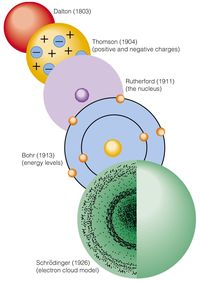
Atomic Models
Quiz
•
Science
•
8th Grade
•
Hard
Standards-aligned

Lisa Thompson
FREE Resource
15 questions
Show all answers
1.
MULTIPLE CHOICE QUESTION
1 min • 1 pt

This is the most complete and current model of the atom. It consists of 61 elementary particles. Electrons are located in complex orbitals.
The "Quantum Mechanical Model" of the atom
The "Rutherford Model" of the atom
The "Plum Pudding Model" of the atom
The "Bohr Model" of the atom
Tags
NGSS.HS-PS1-1
NGSS.HS-PS1-2
2.
MULTIPLE CHOICE QUESTION
1 min • 1 pt

This model this model was the first to show a nucleus, consisting of protons and neutron. Electrons surround the nucleus but are not shown in distinct energy levels.
The "Nuclear Model" by Rutherford
The "Plum Pudding Model" of the atom by Thomson
The "Quantum Mechanical Modell" of the atom by Heisenberg
Democritus's model of the atom
Tags
NGSS.HS-PS1-8
3.
MULTIPLE CHOICE QUESTION
1 min • 1 pt

This model added on to previous models by showing electrons existed at certain "energy levels". It is often called the Planetary Model.
The "Bohr Model" of the atom
The "Rutherford Model" of the atom
The "Plumb Pudding Model" of the atom
The "Quantum Mechanical Model" of the atom
Tags
NGSS.HS-PS1-1
4.
MULTIPLE CHOICE QUESTION
1 min • 1 pt

This model was developed after J.J. Thompson discovered electrons, a particle smaller than an atom. Is shows electrons floating freely in a positive space.
The "Plum Pudding Model" of the atom
The "Rutherford Model" of the atom
Democritus's model of the atom
The "Quantum Mechanical Model" of the atom
5.
MULTIPLE CHOICE QUESTION
1 min • 1 pt
What can you conclude from the fact that scientists continue to update the atomic model?
New information about atoms continues to be discovered
Old information about atoms is completely useless
Scientists did not have any information about atoms until a few years ago
Scientists still have no idea what atoms look like
6.
MULTIPLE CHOICE QUESTION
1 min • 1 pt

Ernest Rutherford discovered that atoms were mostly _________________.
negatively charged
positively charged
electrons
empty space.
7.
MULTIPLE CHOICE QUESTION
1 min • 1 pt
Idea was of an indivisible particle of matter he called "atomos"
John Dalton
Aristotle
Democritus
Plato
Create a free account and access millions of resources
Similar Resources on Wayground

16 questions
History of the Atom
Quiz
•
6th - 8th Grade

10 questions
STRUCTURE OF AN ATOM
Quiz
•
9th - 10th Grade

17 questions
Development of atomic models
Quiz
•
8th - 9th Grade

20 questions
atomic theory
Quiz
•
9th Grade

10 questions
ATOM
Quiz
•
9th Grade

15 questions
Atomic Physics
Quiz
•
10th Grade - University

15 questions
Properties and Classification of Matter
Quiz
•
10th Grade

17 questions
8th 8.1.1 Atoms
Quiz
•
8th Grade
Popular Resources on Wayground

10 questions
Video Games
Quiz
•
6th - 12th Grade

20 questions
Brand Labels
Quiz
•
5th - 12th Grade

15 questions
Core 4 of Customer Service - Student Edition
Quiz
•
6th - 8th Grade

15 questions
What is Bullying?- Bullying Lesson Series 6-12
Lesson
•
11th Grade

25 questions
Multiplication Facts
Quiz
•
5th Grade

15 questions
Subtracting Integers
Quiz
•
7th Grade

22 questions
Adding Integers
Quiz
•
6th Grade

10 questions
Exploring Digital Citizenship Essentials
Interactive video
•
6th - 10th Grade
Discover more resources for Science

20 questions
Physical and Chemical Changes
Quiz
•
8th Grade

22 questions
Newton's Laws of Motion
Lesson
•
8th Grade

20 questions
Distance Time Graphs
Quiz
•
6th - 8th Grade

10 questions
Exploring Newton's Laws of Motion
Interactive video
•
6th - 10th Grade

17 questions
Thermal Energy Transfer
Lesson
•
6th - 8th Grade

10 questions
Exploring Chemical and Physical Changes
Interactive video
•
6th - 10th Grade

18 questions
Water Cycle
Quiz
•
5th - 8th Grade

15 questions
Physical and Chemical Changes
Quiz
•
8th Grade
